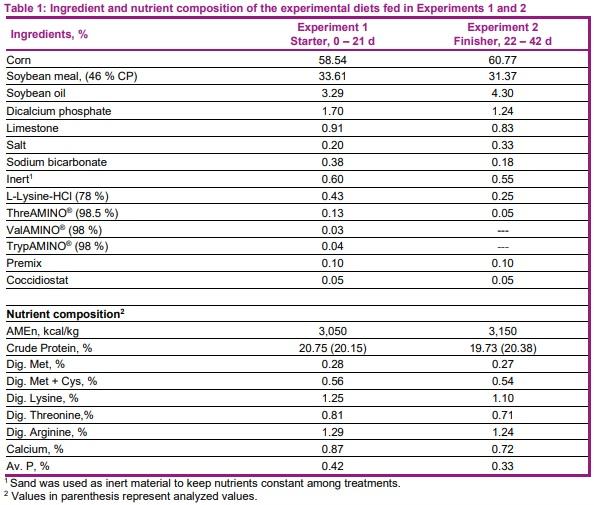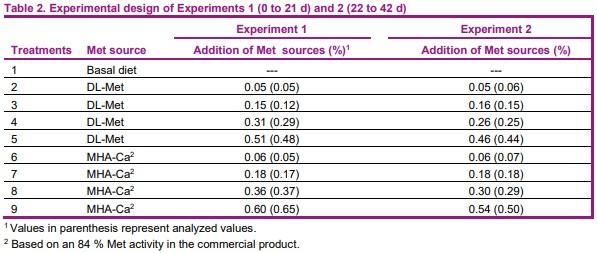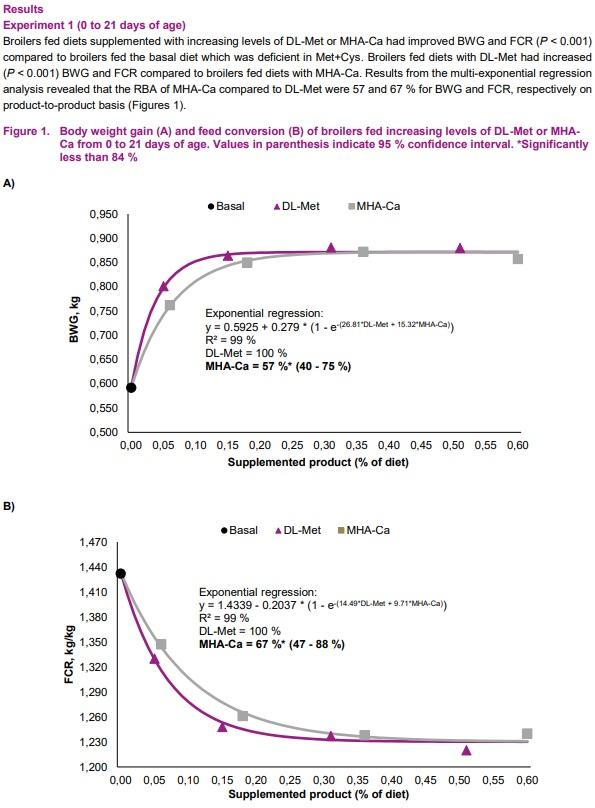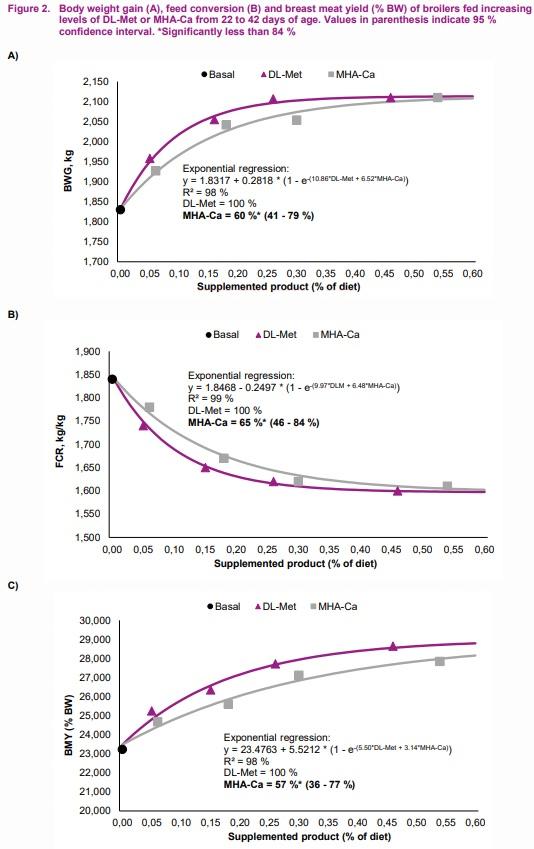Relative bioavailability of DL-methionine hydroxy analogue-calcium salt compared to DL-methionine in starter and finisher broilers
Published: April 26, 2018
By: Letícia Soares 1, Fernando Andres Prado Antayhua 1, Nilva Kazue Sakomura 1, Ariane Helmbrecht 2, and Nei André Arruda Barbosa 3. / 1 Universidade Estadual Paulista, Jaboticabal, São Paulo, Brazil; 2 Evonik Industries, Hanau, Wolfgang, Germany; 3 Evonik Industries, São Paulo, São Paulo, Brazil.
Introduction
Broiler diets are commonly supplemented with dry DL-methionine (DL-Met; 99% active substance), liquid methionine hydroxy analogue-free acid (MHA-FA, 88% active substance) or dry methionine hydroxy analogue-calcium salt (MHA-Ca, 84% active substance). Several broiler trials have demonstrated that the relative bioavailability (RBA) of Met hydroxy analogue products (MHA-FA or MHA-Ca) is on average 65% in relation to DL-Met on product basis (Lemme et al., 2002; Hoehler et al., 2005; Elwert et al., 2008). Knowing and applying the correct RBA value of Met sources is an important factor for cost-effective purchasing and optimizing feed formulation costs. Therefore, two experiments were conducted at UNESP Jaboticabal, Brazil with Prof. Nilva Sakomura to determine the RBA of MHA-Ca in relation to DL-Met in starter (0 to 21 d) and finisher (22 to 42 d) broilers.
Material and Methods
In each experiment, a total of 1,890 day-old Cobb 500 mal broilers were used. Broilers were housed in an environmentally-controlled barn with negative pressure ventilation system to maintain temperature according to breeder's recommendations. Each experiment consisted of 9 dietary treatments with 7 replicates of 30 birds per replicate pen. Corn-soybean meal based diets were formulated to meet or exceed the nutritional recommendations of Rostagno et al., (2011), except for digestible Met+Cys (Table 1). Each experiment consisted of a basal diet deficient in digestible Met+Cys, without supplemental Met, and 4 graded levels of DL-Met and MHA-Ca. Feed in mash form and water were supplied on ad libitum basis in both experiments.
In experiment 1, broilers were fed the experimental diets from 0 to 21 days of age. The basal diet contained 0,56% dig. Met+Cys and was supplemented with four graded levels of DL-Met (0.051, 0.153, 0.309 and 0.513%) or equimolar levels of MHA-Ca (0.060, 0.179, 0.361 and 0.599%; Table 2). Body weight gain (BWG), feed intake (FI), and feed conversion ratio were recorded for the experimental period. In experiment 2, (initial BW = 832 ± 7.35g), broilers were fed the experimental diets from 22 to 42 days of age. The basal diet contained 0.54% dig. Met+Cys and was supplemented with four graded levels of DL-Met (0.054, 0.156, 0.259 and 0.463%) or equimolar levels of MHA-Ca (0.063, 0.183, 0.302 and 0.540%). From 0 to 21 days of age, all broilers were fed the same commercial diet adequate in all nutrients. In addition, 4 birds per replicate were selected and stunned by electronarcosis and subsequently killed to measure breast meat yield (BMY) as a percentage of BW.
Orthogonal contrasts statements were used to compare the responses by the two Met sources against the basal diet and between Met sources. Growth performance and breast meat yield parameters were subjected to multi-exponential regression analyses based on equimolar and product-to-product basis using NLIN procedure (PROC NLIN) of SAS 9.2. As described by Littell et al., (1997) the following equation was applied:
y = a + b (1 − e − (c1.x1 + c2.x2))
where y = the performance or carcass measure; a = the performance or BMY attained with the basal diet; b = the asymptotic response; a + b = the common asymptote (maximum performance level), c1 = the slope coefficient of the DL-Met curve; c2 = the slope coefficient of the MHA-Ca curve; x1 is the dietary level of DL-Met; x2 is the dietary level of MHA-Ca. The RBA was obtained by dividing the slope coefficient of MHA-Ca curve with the slope coefficient for DL-Met curve. In both experiments, the RBA results obtained on equimolar basis when multiplied by 0.84 (active substance in MHA-CA) corresponded to the same results obtained on product-to-product basis. Thus, confirming that the RBA estimates are not affected by either design. In this report, the results on product-to-product basis are presented to allow direct implementation of the RBA figure into practical feed formulation and cost comparison of these Met sources.





Results from these experiments indicate that the average RBA of MHA-Ca compared to DL-Met is 61% on product-to-product basis and independent of the feeding phase. These results confirm that bioavailability of MHA-Ca is significantly lower than its active substance content of 84% and similar to previous research estimates of 65%. This updated information needs to be considered for cost effective purchasing of Met sources and to optimize feed formulation costs.
Conclusion
• Broilers fed the basal diet deficient in Met+Cys had significantly reduced growth performance and carcass yields.
• Supplementation levels of either DL-Met or MHA-Ca improved growth performance and carcass yields.
• Multi-exponential regression analysis revealed a mean bioavailability of MHA-Ca relative to DL-Met on product basis of 62% and 61% for starter and finisher broilers, respectively across all parameters evaluated.
• These results confirm previous reports that have shown that the bioavailability of MHA-Ca compared to DL-Met is on average 65% on product basis and independent of the feeding phase.
Results presented at the PSA Meeting 2016. Poultr. Sci. 95 (E-Suppl. 1) Abstract 259.
This article was originally published in Evonik Nutrition Facts & Figures 15151, November 2017. Reproduced with permission.
Related topics:
Authors:
UNESP - Universidad Estatal Paulista
Evonik Animal Nutrition
Evonik Animal Nutrition
Show more
Influencers who recommended :
Markus WiltafskyRecommend
Comment
Share

Would you like to discuss another topic? Create a new post to engage with experts in the community.











.jpg&w=3840&q=75)